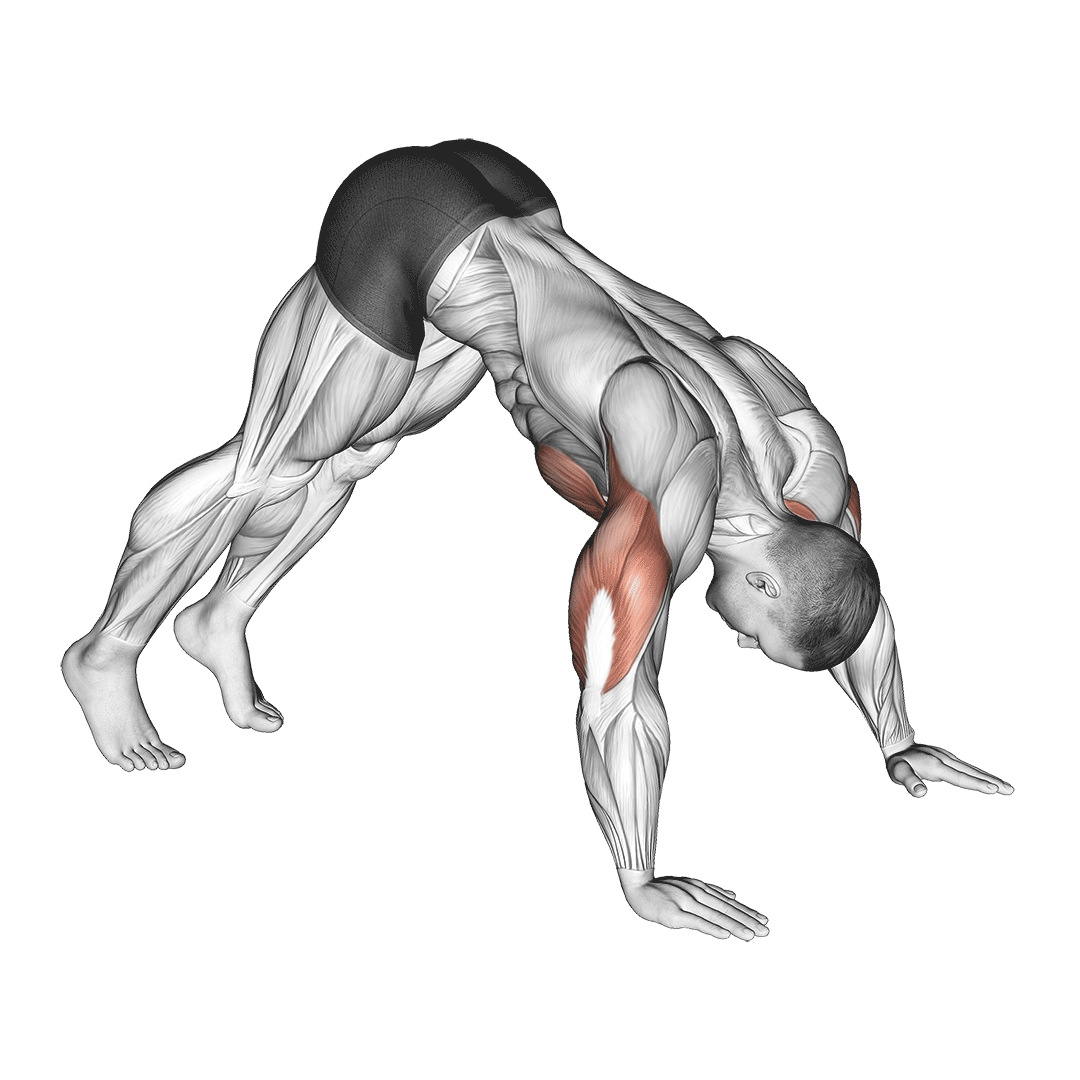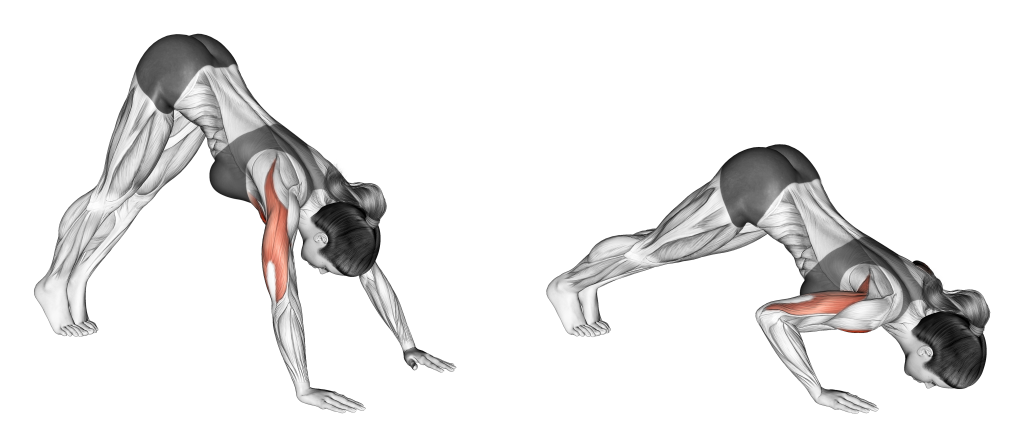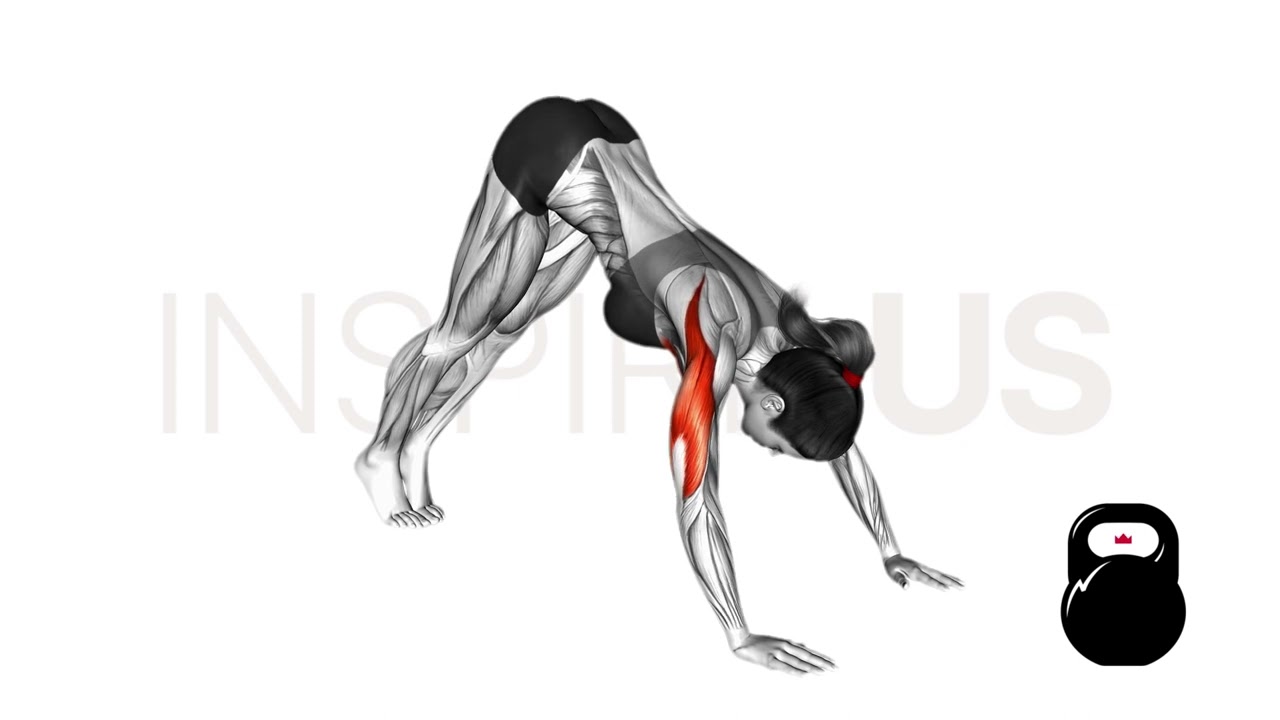Pike Push-Ups: Benefits, Muscles Worked, and More
For calisthenics athletes who have surpassed the standard push-up in terms of training experience, the pike push-up is an excellent way of ensuring that their muscles meet enough challenge to continue steady growth.
However, before throwing this rather effective push-up variation into a training program, it is important to understand the various characteristics and benefits that make it unique among other exercises.
To put it short: the pike push-up is simply a standard push-up variation with the lifter’s pelvis raised into the air, thereby angling the torso more vertically towards the ground. This shifts more of the resistance to the deltoids, and otherwise creates a more challenging exercise in general.
What is the Pike Push-Up?
In more technical terms, the pike push-up is a multi-joint compound exercise that derives all of its resistance from the exerciser’s own bodyweight, thereby classifying it as a calisthenic exercise of moderate difficulty.

It often takes the place of a primary compound movement within a calisthenics workout, or is otherwise used as an adjunct exercise to heavier compound exercises that train the same muscle groups.
Who Should Perform the Pike Push-Up?
The pike push-up is appropriate for all exercisers that are capable of performing a conventional push-up, but is particularly useful for calisthenic athletes wishing to progress onto handstand push-ups or otherwise place greater focus on their deltoids.
What Equipment Does the Pike Push-Up Use?
The pike push-up, being a calisthenic exercise, requires no equipment whatsoever.
How is the Pike Push-Up Performed?
To perform a repetition of the pike push-up, the lifter will enter the standard plank position on the ground, hands parallel with the shoulders.
Then, moving the pelvis upward and forwards so as to form a triangle with their body, the lifter will move their torso forwards and down, with the hands remaining stationary despite the chest rolling forwards.
The elbows will bend towards the rear of the body as they do so, rather than to the sides.
Once the head is within several inches of touching the floor, the lifter will simply reverse the motion so as to complete the repetition.
What Muscles are Worked by the Pike Push-Up?
The pike push-up is a compound exercise, and as such will recruit a number of different muscle groups to different extents.

The muscles utilized (and therefore trained) at the highest intensity are known as the primary mover muscles, whereas muscles utilized only partially during their range of motion or in an isometric capacity are dubbed the secondary mover muscles.
Primary Mover Muscles
When performing a repetition of the pike push-up, it is the muscles of the triceps brachii, the three heads of the deltoids and the pectoral muscles that are worked to the greatest extent.
Secondary and Stabilizer Muscle Groups
Apart from the primary mover muscles, other muscle groups involved in the pike push-up are the serratus, the latissimus dorsi, the core musculature and the biceps brachii.
All but the serratus are utilized in a stabilizing capacity.
What are the Benefits of Doing Pike Push-Ups?
Apart from the usual benefits seen with regular performance of any push-up variation, there are several other effects that the pike push-up alone is capable of imparting to an exerciser - making it invaluable if the following benefits are needed in your training.
Excellent Shoulder Builder
Because of the fact that the pike push-up is capable of placing much of the resistance on the deltoids alone, it is arguably one of the best deltoid builders for calisthenic athletes.
Not only does the greater amount of training stimulus result in deltoid developments, but the dynamic movement and wide range of rotation of the shoulders will also aid in maintaining proper shoulder joint mobility and integrity.
Better Core Stability
As the pike push-up is performed in what is essentially a more intense plank position, it should come as no surprise that significant core muscle improvements can be developed with regular performance of the pike push-up.
Handstand Carryover and Regression
For calisthenic athletes wishing to achieve the feat of handstand push-ups or handstand holds, the pike push-up is the most frequently utilized stepping stone to such exercises.
This is because pike push-ups will acclimate both the mind and body of the lifter to performing handstand exercises, allowing them to become more used to an inverted position under strain while also targeting much the same muscle groups as a handstand exercise would.
Furthermore, such a benefit may also work in reverse.
Exercisers who find handstand push-ups to be too intense for their current training plan may use the pike push-up as a regression exercise, allowing for greater volume and less fatigue to be accumulated within their workout.
Progression to More Advanced Push-Up Variations
While the pike push-up is most often used as a progression step to handstand or other inversion exercises, it can also be excellent for progressing on to more advanced push-up variations such as the planche push-up or single-hand push-up.
The main reason why the pike push-up is not used as often in such a manner is its specificity; the pike push-up places far more focus on the deltoids than other push-up variations, meaning that it is best used as a push-up progression when deltoids are the limiting factor to progression itself.
Unfortunately, this is quite frequently encountered in calisthenic athletes, and as such the pike push-up may actually be quite underutilized in intermediate-to-advanced progression schemes.
Common Mistakes of Pike Push-Ups
Though the pike push-up is primarily performed by intermediate level exercisers with some level of training familiarity, there are still several mistakes that are commonly seen when the pike push-up is being performed.
In order to maximize the benefits of this exercise and to ensure that no injuries occur, it is vital that all exercisers avoid the following common mistakes.
Rounding of the Back and Pelvis
During a repetition of the pike push-up, the exerciser is meant to form a triangle with their entire body, with the pelvis or buttocks acting as the highest point of said triangle.
Whether by failing to contract the core and therefore rounding the lower back or by keeping the pelvis parallel with the back, the exerciser will find that their capacity to maintain a triangular shape (and therefore good form) is greatly diminished in such cases.
In order to create the most stable stance for pike push-ups, the lifter should work on lower back mobility and ensure that their core is properly contracted throughout the exercise.
Recording oneself from the side as they perform pike push-ups may provide insight into whether they are doing so correctly or not.
Performing the Exercise With Excessive Momentum
Like most other push-up variations, performing the pike push-up with excessive downward momentum or a bouncing motion during the latter phase can effectively reduce the benefits of the exercise itself.
Not only is this considered “cheating” the repetition, but it will also create a greater risk of injury than is necessary - especially concerning the shoulder and elbow joints, of which will bear much of the excessive force being produced by failing to control momentum.
Each repetition of the pike push-up should be performed in a slow and controlled manner, and with as full a range of motion as possible.
Feet Set Too Close Together
Not only a mistake made with the pike push-up; setting the feet too close together during most push-up variations can create some level of instability due to a less advantageous positioning of the lower body.
While this can indeed improve core contraction during the exercise, it is not the main focus of the pike push-up, and can even lead to the exerciser losing their balance due to the unusual position in which the pike push-up is performed.
Ideally, the starting stance of each pike push-up repetition should begin with the feet set wider than hip-width apart, thereby maximizing balance and allowing the exerciser to focus on better quality repetitions.
Hands Set Too Far Forward
Just as how setting the feet too close together can lead to instability of the body, so too can setting the hands too far forward sabotage the deltoid-focused training of the pike push-up.
During the pike push-up, the exerciser should place their hands shoulder-width apart and beneath the shoulders, prior to raising their pelvis and forming a triangle with their body.
This ensures that the most advantageous and comfortable hand positioning is maintained, and that there is sufficient space with which to move the head through during the bottom of the range of motion.
Pike Push-Up Variations
If pike push-ups have become too easy for the exerciser but they do not wish to transition to inversion exercises like the handstand push-up, there are several ways of modifying the standard pike push-up so as to amp up the intensity or otherwise shift the focus of the exercise somewhat.
One-Handed Pike Push-Up
In order to intensify the difficulty of the pike push-up, performing it with a single arm alone can both increase the specificity of the training stimulus and make the exercise itself far more challenging.
To do so, the lifter will simply need to maintain a closer stance (from foot to hand) than with a two-handed pike push-up, as well as set their feet slightly wider apart for better balance.
One-Leg Pike Push-Up
For exercisers seeking to improve the core muscle recruitment of the pike push-up, modifying the exercise by raising one leg upwards will cause greater instability in their stance - thereby forcing the core to compensate, resulting in better core contraction and further athletic benefits.
In order to achieve the best results and avoid muscular imbalances, switching the raised leg with each repetition is best.
Decline Pike Push-Up
Not to be confused with a decline conventional push-up, the decline pike push-up is simply a pike push-up with the lower body elevated in some way so as to further increase the range of motion, creating a longer time under tension and better targeting the entirety of the deltoid muscles.
While the decline pike push-up is more challenging and therefore more effective than the conventional pike push-up, it is also more difficult to maintain, and as such should only be performed once the exerciser is capable of performing multiple pike push-up repetitions in a single set.
Frequently Asked Questions (FAQ)
What are Pike Push-Ups Good for?
Pike push-ups are excellent for building shoulder strength alongside working the triceps and pectoral muscles.
Furthermore, they are frequently used by calisthenic athletes as a “stepping stone” between conventional push-ups and handstand push-ups, as well as other handstand-based bodyweight exercises.
Are Pike Push-Ups Harder Than Regular Push-Ups?
In some ways - yes, the pike push-up is harder than a regular push-up.
The pike push-up requires greater core stability and shoulder muscle strength, and is slightly more intense than the standard push-up, especially when performed for high volume sets.
Do Pike Push-Ups Build Traps?
Yes - pike push-ups will recruit the upper portion of the trapezius muscles to a moderate extent, though much of the resistance of the exercise will be borne by the deltoids and triceps instead.
If bodyweight trapezius training is the goal of your workout, you may see better results from inverted rows and pull-ups, as these exercises target the entirety of the trapezius to a far more effective degree.
Final Thoughts
Pike push-ups are an excellent way of targeting the deltoids in a manner that is entirely compatible with a bodyweight or home gym workout - not to mention just plain effective to boot.
If performed with correct form, rest assured that the pike push-up will produce excellent results in line with its many benefits, including better shoulder and tricep growth as well as allow for handstands to be performed with greater efficiency.
Remember to always perform the exercise with proper form and programming, and if you are unsure of how to go about doing either, that there is no shame in seeking out advice.
References
1. Kowalski KL, Connelly DM, Jakobi JM, Sadi J. Shoulder electromyography activity during push-up variations: a scoping review. Shoulder & Elbow. 2022;14(3):325-339. doi:10.1177/17585732211019373
2. Schwarznegger, Arnold. Dobbins, Bill. (Nov 5, 1999) “The New Encyclopedia of Modern Bodybuilding : The Bible of Bodybuilding, Fully Updated and Revised EBook Edition” Simon and Schuster Publishing ISBN-10: 3200328452
3. Roberts, Dale L. (Dec 7, 2015) “An Ultimate Home Workout Plan Bundle: The Very Best Collection of Exercise and Fitness Books” CreateSpace Independent Publishing Platform ISBN-10: 1519734840

